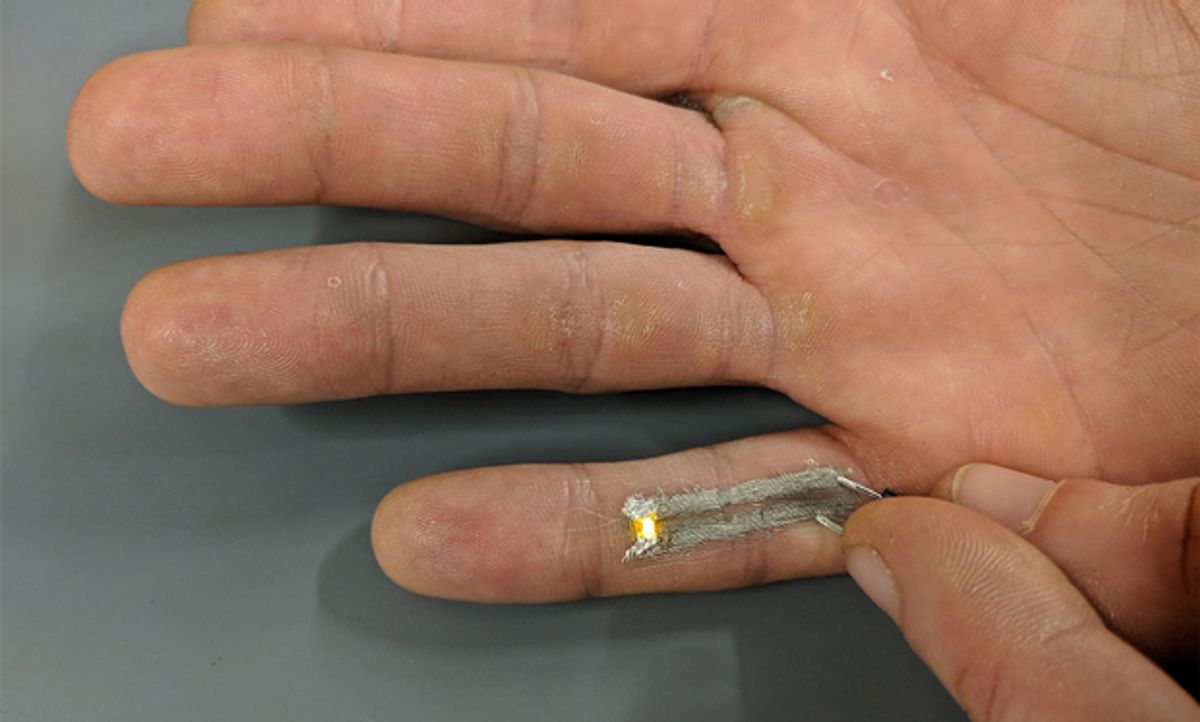Nick Williams didn’t ask permission. The graduate student just stuck his pinky finger under the printer and watched it paint two silver lines on his skin. When printing was complete, Williams put a small LED light at one end of the lines and applied voltage to the other. He smiled as the light glowed.
Williams showed the electronically active tattoo to his advisor, Duke University electrical engineer Aaron Franklin. Since Williams barely felt the printing, and the silver washed off with soap and water, they tried it again.
Flexible electronics are having a moment. The sheer range of devices developed recently demonstrates the scope and speed of the field, including patches to communicate with robots, wearables to reverse baldness or detect heartbeats, and solar cells that can be sewn into clothing.
But Williams’s new temporary tattoo was a novelty because electronic components aren’t usually printed onto skin or other sensitive materials. Printed electronics typically require post-processing such as oven baking or chemical baths to remove residual liquids and unwanted materials that interfere with electric fields.
In two recent papers, Franklin, Williams and colleagues at Duke demonstrate a low-temperature technique for printing electrical components—including leads and transistors—onto delicate surfaces such as apples, human skin and paper, with no post-processing required.
“Ultimately it doesn’t matter if it’s paper or plastic or what-not, you want to be able to put your surface in, add printed, functional electronics to that surface, and away you go,” says Franklin. The new technique enables researchers to print electronic components onto a wide range of materials and reduces overall production complexity and time, he says.

In a July paper in the journal Nanoscale, the team printed silver nanowire ink onto a variety of surfaces using an aerosol jet printer, which turns liquid ink into an aerosol form by infusing it with an inert gas such as nitrogen.
The silver nanowire ink, as opposed to silver nanoparticles or other conductive materials, enabled the team to print conductive lines at near-room temperature, which made Williams hypothesize that it should work on skin. Additionally, silver nanowires are biocompatible, while silver nanoparticles—a commonly used material in other printed electronics—raise toxicity concerns.
In a second paper, published this month in ACS Nano, Franklin and colleagues created flexible thin-film transistors by printing layers of semiconducting carbon nanotubes, silver nanowire ink, and a graphene-like insulating ink called hexagonal boron nitride (h-BN). “We honestly didn’t know [if it would work], so we just tried,” Franklin told IEEE Spectrum.
When the transistors were complete, the team baked a few at high-temperatures to see if it would improve the performance. “They did not actually get better,” says Franklin. That surprise suggests that low-temperature printing without post-processing will not diminish the performance of electronics printed in this way.
Numerous other labs are exploring the use of flexible electronics as biosensors, with impressive techniques for making and transferring electronics to flexible, tattoo-like stickers, says Franklin. Therefore, the low-temperature printing could perhaps be most useful for bespoke applications, such as custom bandages made for patients on-the-spot to monitor a set of biological indicators requested by a doctor.
Last year, Franklin’s spinout company, Tyrata, Inc., raised $4.5 million to commercialize carbon nanotube sensors to monitor tire tread. While Franklin has no immediate plans to start a company related to the low-temperature printing, the lab is working to improve the performance of the devices and continue to lower the printing temperature, he says. Plus, Franklin plans to start developing biosensors.

“We don’t want to just print conductive traces onto human skin,” says Franklin. “We want to actually show we can do a full printing on any surface with useful, functional biosensing devices.”
Megan Scudellari is an award-winning freelance journalist based in Boston, Massachusetts, specializing in the life sciences and biotechnology. She was previously a health columnist for the Boston Globe and has contributed to Newsweek, Scientific American, and Nature, among others. She is the co-author of a college biology textbook, “Biology Now,” published by W.W. Norton. Megan received an M.S. from the Graduate Program in Science Writing at the Massachusetts Institute of Technology, a B.A. at Boston College, and worked as an educator at the Museum of Science, Boston.



